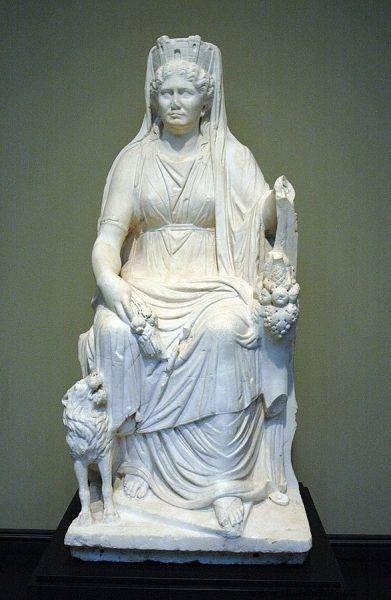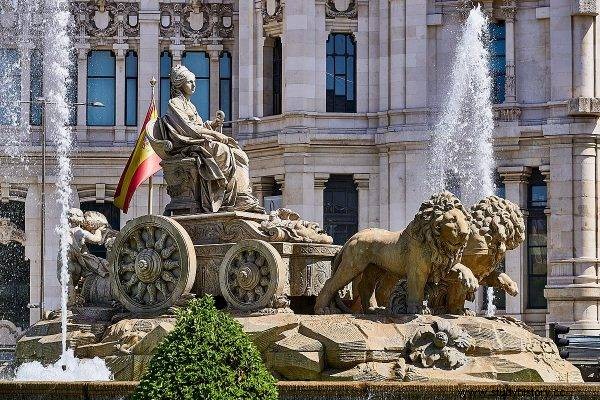Remains of a Roman temple were found during the reconstruction of St. Peter's Square. It turned out that it belonged to the Phrygian goddess Magna Mater, which the Romans decided to win over to their side during one of the most important battles in history. Along with the goddess, her blood priests were also brought into the city.
The Vatican Hill is situated on the other side of the Tiber River (in relation to the seven hills) and originally did not belong to the borders of the ancient city of Rome. Already the ancients doubted the origin of its name. Varron connected her with the god Vagitanus, who was to patronize the first cry of a newborn child. Another explanation has to do with the Etruscan settlement of Vatica or Vaticum.
Cicero referred to the name Vaticani Montes, which as a plural suggests that it was a larger area that most likely stretched from the Vatican Hill to the Tiber. Over the centuries it has been used in many ways. Archaeological excavations have shown that there was also Phrygianum, the temple of the goddess Magna Mater, also known as Cybele.
And although this temple was not the most important temple dedicated to this goddess in the empire (this one was on the Palatine), its fame and importance were so great that in some parts of the Empire, imitations of her were erected. Who was the bloody goddess who was worshiped where the walls of the Vatican would later stand?
Mother of all things
Magna Mater, also known as Cybele, was the Phrygian goddess of land, fertility, fertility and wild nature. She was considered the mother of all things. In Greece, her cult was introduced at the turn of the 7th and 6th centuries BCE. She was very quickly connected with the goddess Demeter (in this role she received power over nature) and Rea which made her the mother of the gods of Olympus.
Due to the nature of the celebration, the celebration of its holidays was quickly combined with the mysteries in honor of Dionysus, and with time also with the worship of the god of the Lord. In the 5th century BC the goddess already had her standardized image. She was depicted sitting in a Greek robe. Its attributes were a libation bowl and a tympanum. At that time, she was also accompanied by lions.

Roman cybele, c. 50 C.E.,
Cybele was believed to have magical powers. People sought justice and vengeance in her. She could send misfortunes and diseases, but also protect and heal from them. Because of this duality, she was one of the goddesses who were both adored and hated.
Mother Goddess Greeting
The Romans had a fairly loose religious policy. This, moreover, allowed them to keep the great empire in check for such a long time. It was common to absorb foreign deities into the Roman pantheon. One such practice was evocatio , that is, the habit of dragging them to your website. Let's face it - bribery!
It was through evocation, on the order of the Sibylline Books, that the Great Mother Goddess was accepted into the Roman pantheon, whose cult was introduced in 204 BCE. as a thank you for helping me fight during the Second Punic War . However, bribing the goddess in exchange for turning away from Hannibal had consequences that the Romans had not yet had a clue about.

Vatican - the capital of popes, premiere at POLSAT VIASAT HISTORY on Sunday, February 7, at 21:00
Unlike Greece, where Cybele was rather a private deity, in Rome she immediately became an element of public worship. The black stone of the goddess was quickly transported to the capital of the empire from Phrygia, which was later placed in her temple on the Palatine.
In honor of Magna Mater, an annual festival was also established in its honor, called Megalesia. It lasted from April 4 to 10. It was so specific and bloody that the Romans ... were forbidden to take part in the celebrations.
Worship of the goddess
The festival in honor of the goddess was most likely held in her temple on the Palatine, where theatrical performances were to take place in her presence. The plays of Terentius and Plautus were staged. According to Cicero, games were organized in front of the temple. However, this is unlikely given the very limited space. It is possible that they were carried out in the valley under the hill so that the goddess could "participate" in them.
One of the elements of the cult of Magna Mater were the processions of priest-eunuchs called Galli. In a frenetic march, they carried a statue of their patron in a litter in the streets of Rome. Cybele was depicted riding in a chariot pulled by lions, with a crown of war on her head. Her servants, stained with blood from self-flagellation, sang Greek hymns to the accompaniment of drums, horns and cymbals and asked passers-by for alms. The procession participants also carried weapons that symbolized their fury. After a while, an armed group joined them and began a mock skirmish.
During the empire, the cult of Magna Mater began to grow significantly. One of the March weeks was also dedicated to her honor. His celebration contained many more cult aspects - including elements of orgiastic bloodbaths and mysteries.
Blood Bath
One element of the developing Cybele cult was taurobolium that is, the ritual sacrifice of the bull. The ceremony was held in honor of Magna Mater and its divine partner, Attis.

Cybele was depicted riding in a chariot pulled by lions, with a crown of war on her head.
The priest descended under a special structure and stood in a hollow. Above him, on an openwork altar, an animal was sacrificed, and its blood flowed onto the servant of the goddess. In this way, purification and rebirth was accomplished.
In Christian times, bloody rituals were forbidden by the emperors . The temples of the goddess also lost their importance. Gradually, they were replaced by sacred objects of the new faith. Excavations near St. Peter's Square proved that there were structures related to the cult of Cybele in this place. Altars and inscriptions related to the taurobolium performed here have been discovered .
Literature:
- B. Bogh, The Phrygian Background of Kybele , "Numen" 54 (2007), pp. 304-339.
- M. J. Vermaseren, Cybele and Attis:the Myth and the Cult , London 1977.
- G. Showerman, The Great Mother of the Gods , "Bulletin of the University of Wisconsin," No. 43; Philology and Literature Series, 1.3 (1901).
- W. Warde Fowler, The Roman Festivals oft he period of the Republic. An introduction to the study of the religion of the Romans , Port Washington, N.Y./London 1969.
